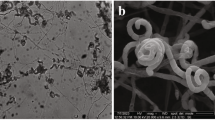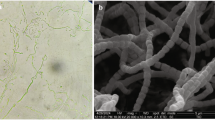Abstract
A novel actinobacterial strain, designated S10T, was isolated from a sand sample collected from the Qaidam Basin in Qinghai province, China. The strain S10T exhibited antibacterial activity against MRSA. The taxonomic position of the strain S10T was determined by a polyphasic approach. There were six copies of 16S rDNA in S10T which were not same exactly (MH257693-MH257698). Phylogenetic analysis of 16S rRNA gene sequences indicated the strain belonging to the genus Streptomyces and it showed high sequence similarities with Streptomyces chartreusis NBRC 12753T (99.31%), Streptomyces phaeoluteigriseus DSM 41896T (99.24%), Streptomyces variegatus NRRL B-16380T (99.17%) and Streptomyces flavovariabilis NRRL B-16367T (99.17%) comparing with MH257693, MH257695, MH257696, MH257697, and MH257698. Similarities with Streptomyces kunmingensis NBRC14463T (98.82%), Streptomyces bungoensis DSM 41781T(98.76%), S. chartreusis NBRC 12753T (98.69%) and S. phaeoluteigriseus DSM 41896T (98.62%) with MH257694. Whole-genome average nucleotide identity (ANI) values between strain S10T and S. chartreusis NBRC 12753T, S. phaeoluteigriseus DSM 41896T, S. variegatus NRRL B-16380T, S. flavovariabilis NRRL B-16367T, S. kunmingensis NBRC 14463T, S. bungoensis DSM 41781T were 83.63%, 82.89%, 92.55%, 92.51%, 79.29, and 82.87%, respectively, suggesting that the strain S10T represented a new species. A phylogenetic analysis comparing the S10T genome with those of 336 other sequenced Streptomyces genomes confirmed its relatedness with Streptomyces variegatus NRRL B-16380T and Streptomyces flavovariabilis NRRL B-16367T. Strain S10T contained LL-diaminopimelic acid in the cell wall. The predominant menaquinones were MK-9(H6) and MK-9(H8) and the major fatty acids were iso-C15:0, anteiso-C15:0, iso-C16:0, and anteiso-C17:0. Phospholipids detected were diphosphatidyl glycerol, phosphatidyl ethanolamine, phosphatidyl choline, three unknown phospholipids, an unknown aminophospholipid and an unknown phosphatidyl glycolipid. On the basis of these genotypic and phenotypic data, it is proposed that isolate S10T (=JCM 31184T =CGMCC 4.7315T) should be classified in the genus Streptomyces as Streptomyces qaidamensis sp. nov.
Similar content being viewed by others
Log in or create a free account to read this content
Gain free access to this article, as well as selected content from this journal and more on nature.com
or
References
Waksman SA, Henrici AT. The nomenclature and classification of the actinomycetes. J Bacteriol. 1943;46:337–41.
Lechevalier MP, Lechevalier H. Chemical composition as a criterion in the classification of aerobic actinomycetes. Int J Syst Bacteriol. 1970;20:435–43.
Anderson AS, Wellington EMH. The taxonomy of Streptomyces and related genera. Int J Syst Evol Microbiol. 2001;51:797–814.
Manfio G. P., Zakrzewska-Czerwinska J., Atalan E. & Goodfellow, M. Towards minimal standards for the description of Streptomyces species. Biotechnologiia. 1995;226: 228–237.
Goodfellow M, Fiedler HP. A guide to successful bioprospecting: informed by actinobacterial systematics. Antonie Van Leeuwenhoek. 2010;98:119–42. https://doi.org/10.1007/s10482-010-9460-2
Bérdy J. Thoughts and facts about antibiotics: where we are now and where we are heading. J Antibiot. 2012;65:385–95.
Mohammadipanah F, et al. Streptomyces zagrosensis sp. nov., isolated from soil. Int J Syst Evol Microbiol. 2014;64:3434–40. https://doi.org/10.1099/ijs.0.064527-0
Rottig A, et al. Analysis and optimization of triacylglycerol synthesis in novel oleaginous Rhodococcus and Streptomyces strains isolated from desert soil. J Biotechnol. 2016;225:48–56. https://doi.org/10.1016/j.jbiotec.2016.03.040
Zhang B, et al. The diversity and biogeography of the communities of Actinobacteria in the forelands of glaciers at a continental scale. Environ Res Lett. 2016;11:054012.
Enright MC, et al. The evolutionary history of methicillin-resistant Staphylococcus aureus (MRSA). Proc Natl Acad Sci USA. 2002;99:7687–92. https://doi.org/10.1073/pnas.122108599
Shirling Et, Gottlieb D. Methods for characterization of Streptomyces species. Int J Syst Evol Microbiol. 1966;16:313–40.
Waksman SA. The Actinomycetes. A summary of current knowledge (Ronald, New York, 1967).
Gordon RE, Barnett DA, Handerhan JE, Pang HN. Nocardia coeliaca, Nocardia autotrophica, and the Nocardin Strain. Int J Syst Evol Microbiol. 1974;24:54–63.
Yokota A, Tamura T, Hasegawa T, Huang LH. Catenuloplanes japonicus gen. nov., sp. nov., nom. rev., a new genus of the order Actinomycetales. Int J Syst Bacteriol. 1993;43:805–12.
Moore PC, Lindsay JA. Molecular characterisation of the dominant UK methicillin-resistant Staphylococcus aureus strains, EMRSA-15 and EMRSA-16. J Med Microbiol. 2002;51:516–21. https://doi.org/10.1099/0022-1317-51-6-516
Staneck JL, Roberts GD. Simplified approach to identification of aerobic actinomycetes by thin-layer chromatography. Appl Microbiol. 1974;28:226–31.
Collins MD, Pirouz T, Goodfellow M, Minnikin DE. Distribution of menaquinones in actinomycetes and corynebacteria. J Gen Microbiol. 1977;100:221–30.
Kroppenstedt RM. Separation of bacterial menaquinones by HPLC using reverse phase (RP18) and a silver loaded ion exchanger as stationary phases. J Liq Chromatogr. 1982;5:2359–67. https://doi.org/10.1080/01483918208067640.
Minnikin DE, et al. An integrated procedure for the extraction of bacterial isoprenoid quinones and polar lipids. J Microbiol Meth. 1984;2:233–41.
Sasser, M. Identification of Bacteria by Gas Chromatography of Cellular Fatty Acids, MIDI Technical Note 101 (MIDI Inc., Newark, DE, USA, 1990).
Kampfer P, Kroppenstedt RM. Numerical analysis of fatty acid patterns of coryneform bacteria and related taxa. Can J Microbiol. 1996;42:989–1005.
Harunari E, et al. Streptomyces hyaluromycini sp. nov., isolated from a tunicate (Molgula manhattensis). J Antibiot. 2016;69:159–63. https://doi.org/10.1038/ja.2015.110.
Kim OS, et al. Introducing EzTaxon-e: a prokaryotic 16S rRNA gene sequence database with phylotypes that represent uncultured species. Int J Syst Evol Microbiol. 2012;62:716–21. https://doi.org/10.1099/ijs.0.038075-0.
Saitou N, Nei M. The neighbor-joining method: a new method for reconstructing phylogenetic trees. Mol Biol Evol. 1987;4:406–25.
Felsenstein J. Evolutionary trees from DNA-sequences - a maximum-likelihood approach. J Mol Evol. 1981;17:368–76. https://doi.org/10.1007/Bf01734359.
Tamura K, et al. MEGA5: molecular evolutionary genetics analysis using maximum likelihood, evolutionary distance, and maximum parsimony methods. Mol Biol Evol. 2011;28:2731–9. https://doi.org/10.1093/molbev/msr121.
Jukes TH, Cantor CR. Evolution of protein molecules. Mamm Protein Metab. 1969;3:21–132.
Felsenstein J. Confidence limits on phylogenies: an approach using the bootstrap. Evolution. 1985;39:783–91.
Tamaoka J, Komagata K. Determination Of DNA-Base Composition by Reversed-Phase High-Performance Liquid-Chromatography. FEMS Microbiol Lett. 1984;25:125–8. https://doi.org/10.1111/j.1574-6968.1984.tb01388.x.
Goris J, et al. DNA–DNA hybridization values and their relationship to whole-genome sequence similarities. Int J Syst Evol Microbiol. 2007;57:81–91.
Segata N, Börnigen D, Morgan XC, Huttenhower C. PhyloPhlAn is a new method for improved phylogenetic and taxonomic placement of microbes. Nat Commun. 2013;4:2304.
Miller MA, Pfeiffer W, Schwartz T. Gateway Computing Environments Workshop. 1–8.
Williams ST, et al. Numerical classification of Streptomyces and related genera. J Gen Microbiol. 1983;129:1743–813.
Kim M, Oh H-S, Park S-C, Chun J. Towards a taxonomic coherence between average nucleotide identity and 16S rRNA gene sequence similarity for species demarcation of prokaryotes. Int J Syst Evol Microbiol. 2014;64:346–51.
Li J, et al. Streptomyces endophyticus sp. nov., an endophytic actinomycete isolated from Artemisia annua L. Int J Syst Evol Microbiol. 2013;63:224–9.
Ruan J, et al. Chainia kunmingensis, a new actinomycete species found in soil. Int J Syst Evol Microbiol. 1985;35:164–8.
Zhang R, et al. Streptomyces luozhongensis, sp. nov. a novel actinomycete with antifungal activity and antibacterial activity. Antonie Van Leeuwenhoek. 2016;110:195–203.
Acknowledgements
This work was funded by the National Science Foundation of China (No. 31470544, 31570498), National Science Foundation of Gansu (17JR5RA308), SKLCS-OP-2018–10, BBSRC, UK (grant BB/J020419/1) and CAPES, Brazil (88887.125175/2015–00).
Author information
Authors and Affiliations
Corresponding authors
Ethics declarations
Conflict of interest
The authors declare that they have no conflict of interest.
Electronic supplementary material
Rights and permissions
About this article
Cite this article
Zhang, B., Tang, S., Chen, X. et al. Streptomyces qaidamensis sp. nov., isolated from sand in the Qaidam Basin, China. J Antibiot 71, 880–886 (2018). https://doi.org/10.1038/s41429-018-0080-9
Received:
Revised:
Accepted:
Published:
Issue date:
DOI: https://doi.org/10.1038/s41429-018-0080-9



